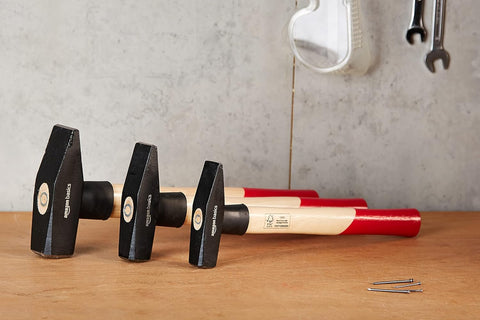To display precious artworks securely and aesthetically, having the proper professional-grade tools on hand is essential. Hanging artwork can seem deceptively simple - just a nail in the wall, right? Yet perfectly installing art and galleries goes far beyond just eyeballing nail placement.
In this guide, we reveal the must-have tools experts use for quality art installation. We’ll walk through how to use each gadget so you can hang artworks like a seasoned pro. With this pro toolkit, you’ll never struggle with crooked frames or damaged walls again. Let’s get started mastering the art of art hanging!
Screwdrivers
Screwdrivers are essential for installing any hanging hardware that requires screws, such as brackets, cleats, anchors, etc.
- Screwdrivers are used to install screws with cross-shaped heads, the most common type used in hanging hardware. A medium head screwdriver is ideal for most hardware screws.
- Flat head screwdrivers are necessary for adjusting hardware like hanging wire locks or D-rings on the backs of frames. The flat head allows manoeuvring within tight spaces.
- Power drills with screwdriver bits make driving screws into studs or drywall anchors quick and easy without wrist strain. Cordless drills provide freedom of movement.
Tape Measures
Tape measures are vital tools that allow installers to make accurate measurements when positioning and spacing artworks or paintings on walls. A quality tape measure enables measuring the precise distances between multiple pieces to achieve the desired visual arrangement, ensuring an evenly distributed gallery layout. Tape measures also facilitate measuring the exact distances of paintings from the ceiling, floor, and adjacent walls based on the desired visual impact. Without reliable tape measures, eyeballing these measurements often leads to uneven spacing or awkward positioning of paintings on the wall. Extendable tape measures further facilitate measuring drop distances and high walls solo.
Being able to accurately quantify the required spacing and distances between components during the layout process results in a polished, balanced appearance. Tape measures make it easy to translate plans to reality when mounting multiple artworks by enabling precision installation tailored to the unique space.
Stud Finders
Stud finders play a critical role in allowing installers to securely mount heavy or large artworks prone to pull-out or fall hazards. A quality stud finder accurately locates the wood studs hidden behind drywall that provide sturdy anchors for hanging hardware. Rather than driving nails randomly into drywall alone, using a stud finder to pinpoint stud edges and centres allows precisely targeting the optimal load-bearing points. This prevents hardware ripped out of drywall and provides reinforced protection against valuables crashing down, even if they are accidentally hit or bumped.
For heavy pieces like wide horizontal paintings or large mirrors, a stud finder reduces unnecessary holes in the walls and wasted time guessing at stud locations. Fast electronic stud finders take the frustration and guesswork out of finding hidden structural framing when hanging substantial artworks, helping ensure safety and durability. The ability to reliably locate studs makes mounting art a breeze.
Hammers
A picture hanging hammer allows gently tapping nails into studs or anchors without marring walls. Smooth faced hammers prevent damage. Hammers provide a means to securely fasten hanging hardware and nails during the artwork installation process. Picture hanging hammers allow gently tapping nails into wall studs or drywall anchors without damaging the surrounding wall surface. The smooth, flat heads are designed to prevent marring, denting, or peeling the wallpaper or paint when driving nails. Without the proper hammer, makeshift tools could crack plaster or tile surfaces.
Using an undersized hammer leads to ineffective nudging of nails, while oversized hammers damage walls and crush nails. Proper picture hanging hammers also have magnetic nail starter grooves on the head to easily align nails before striking. The lightweight but sturdy construction gives installers control while affixing hardware. Having the right hammer helps ensure nails are secured just firmly enough without weak mounts or unnecessary aesthetical damage to walls. It's an indispensable tool for safely and effectively setting hardware and hangers.
Ladders
Ladders play an important role in allowing installers to easily and safely access hard-to-reach areas when hanging art and paintings. A sturdy, lightweight ladder enables installers to securely position themselves at heights above normal reach levels to install hardware, align paintings, adjust hanging wires, and perform any other necessary tasks. Without a reliable ladder or step stool, attempting to mount artwork high up on walls can result in dangerous stretching, climbing on furniture, and accidental slips or falls.
A good ladder also provides flexibility for the installer to move to different areas and angles during the hanging process. Investing in a ladder designed for stability, grip, and manoeuvrability in interior spaces makes properly installing tall or ceiling-high paintings much more efficient and secure. Ladders minimize physical strain and reduce the need for extra helpers when mounting artwork out of arm's reach.
Conclusion
The article provided an in-depth overview of the critical tools needed to professionally install art and paintings. It explains how screwdrivers, levels, tape measures, stud finders, pencils, painter's tape, picture hanging kits, hammers, wire cutters, hanging templates, ladders, and vacuums each serve a vital purpose in the process. Highlights include how stud finders allow securely targeting structural framing, levels keep pieces straight, tape measures enable precise spacing, hammers drive in hardware securely without damage, ladders provide safe access, and vacuums clean up debris. Having this complete toolkit prevents frustration, mistakes, and injuries while enabling museum-quality art hanging. Investing in the right specialized tools leads to efficient, professional results.







